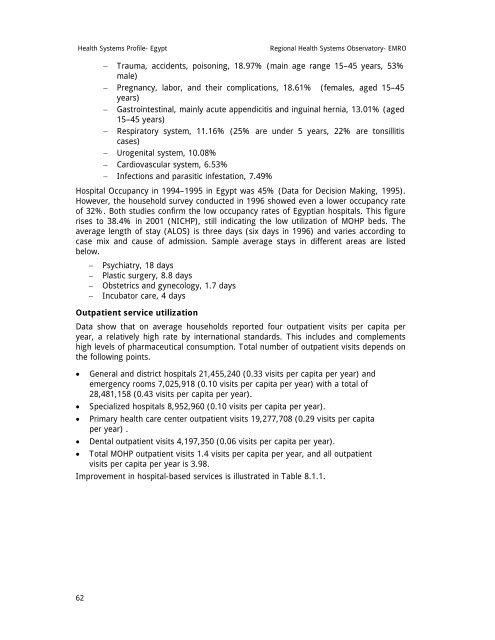Egypt : Complete Profile - What is GIS - World Health Organization
Egypt : Complete Profile - What is GIS - World Health Organization
Egypt : Complete Profile - What is GIS - World Health Organization
Create successful ePaper yourself
Turn your PDF publications into a flip-book with our unique Google optimized e-Paper software.
<strong>Health</strong> Systems <strong>Profile</strong>- <strong>Egypt</strong> Regional <strong>Health</strong> Systems Observatory- EMRO<br />
− Trauma, accidents, po<strong>is</strong>oning, 18.97% (main age range 15–45 years, 53%<br />
male)<br />
− Pregnancy, labor, and their complications, 18.61% (females, aged 15–45<br />
years)<br />
− Gastrointestinal, mainly acute appendicit<strong>is</strong> and inguinal hernia, 13.01% (aged<br />
15–45 years)<br />
− Respiratory system, 11.16% (25% are under 5 years, 22% are tonsillit<strong>is</strong><br />
cases)<br />
− Urogenital system, 10.08%<br />
− Cardiovascular system, 6.53%<br />
− Infections and parasitic infestation, 7.49%<br />
Hospital Occupancy in 1994–1995 in <strong>Egypt</strong> was 45% (Data for Dec<strong>is</strong>ion Making, 1995).<br />
However, the household survey conducted in 1996 showed even a lower occupancy rate<br />
of 32%. Both studies confirm the low occupancy rates of <strong>Egypt</strong>ian hospitals. Th<strong>is</strong> figure<br />
r<strong>is</strong>es to 38.4% in 2001 (NICHP), still indicating the low utilization of MOHP beds. The<br />
average length of stay (ALOS) <strong>is</strong> three days (six days in 1996) and varies according to<br />
case mix and cause of adm<strong>is</strong>sion. Sample average stays in different areas are l<strong>is</strong>ted<br />
below.<br />
− Psychiatry, 18 days<br />
− Plastic surgery, 8.8 days<br />
− Obstetrics and gynecology, 1.7 days<br />
− Incubator care, 4 days<br />
Outpatient service utilization<br />
Data show that on average households reported four outpatient v<strong>is</strong>its per capita per<br />
year, a relatively high rate by international standards. Th<strong>is</strong> includes and complements<br />
high levels of pharmaceutical consumption. Total number of outpatient v<strong>is</strong>its depends on<br />
the following points.<br />
• General and d<strong>is</strong>trict hospitals 21,455,240 (0.33 v<strong>is</strong>its per capita per year) and<br />
emergency rooms 7,025,918 (0.10 v<strong>is</strong>its per capita per year) with a total of<br />
28,481,158 (0.43 v<strong>is</strong>its per capita per year).<br />
• Specialized hospitals 8,952,960 (0.10 v<strong>is</strong>its per capita per year).<br />
• Primary health care center outpatient v<strong>is</strong>its 19,277,708 (0.29 v<strong>is</strong>its per capita<br />
per year) .<br />
• Dental outpatient v<strong>is</strong>its 4,197,350 (0.06 v<strong>is</strong>its per capita per year).<br />
• Total MOHP outpatient v<strong>is</strong>its 1.4 v<strong>is</strong>its per capita per year, and all outpatient<br />
v<strong>is</strong>its per capita per year <strong>is</strong> 3.98.<br />
Improvement in hospital-based services <strong>is</strong> illustrated in Table 8.1.1.<br />
62

















